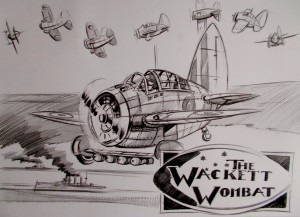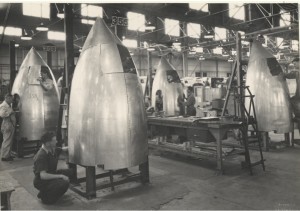In response to the requirement for a small, inexpensive intercept fighter as a consequence of the fall of Singapore in 1942, several local companies, (among them Wackett) were commissioned with the task of developing a very simple aircraft that would not require the use of valuable war material, duralinium, and expensive machining. Seizing the spirit of the day the Melbourne Sun, sponsored the “Build a Beauty” competition in which the promise of a significant prize, (up to five hundred pounds) was on offer for the most successful entry. Amongst the several prototypes, (the Simpson Steele-Rudd, the Hills Hoister, and the Bakelite Birko) none impressed more than the Wackett Wombat. The Wombat seemed to have it all combining simplicity, durability and exceptional performance.

Wacket Wombat of no 3 squadron RAAF performng acrobatics and fleet flyover Jervis Bay N.S.W. circa 1939.
The Wombat, brainchild of chief designer Lawrence Hardnutt combined all the requirements as specified and gave both the operator, (the RAAF) and support crew, an edge in delivery, (each aircraft took only two days to assemble) and ease of maintenance. Central to the Wackett, the power unit was an adapted Armstrong Siddeley Cheetah 1X radial piston engine. Then in use on the Avro Anson, and the Airspeed Queen Wasp. Wackett, by combining this basic engine and up-engineering the carburettion and magnetos developed a stunning 450 hp, which gave the airframe (at a mere 1890 lbs) breathtaking agility and good performance at both high and low level. The sales pitch was impressive, rather than adding to the confusion of existing assembly of Fairy Battle, Bristol Beaufort and Wirraway aircraft, the Wombat required a basic knowledge of carpentry, a degree of competency with a screwdriver, an Allen key and an attention to plans and basic design detail that was in Hardnutt’s words, “not beyond the skill level of the average scout group’.

Scout Masters inspecting completed fuselage sections prior to delivery and mating with Armstrong Siddeley Cheetah Engines. In foreground Mr. Cyril Polkinghorne esq, (8th Prahran Scout Group) reading inscription dedicated to Lord Baden Powell.
With this determination the Government subcontracted assembly to some 1200 Scout groups, Primary Schools and Technical Colleges. All, under the ‘You’re on a Wacket’s Wicket‘ slogan, and the catchy jingle ‘Bob a job, wack a Jap’, All readied for Wombat assembly. And just in time.
The bombing of Darwin in February 1942, caused widespread panic, and within a week the first Wombat squadron was ready for active service. After a few anxious weeks the Wombat squadron whose motto, ‘Consumit, Legumit, Valete’, (eats, roots and leaves) was scrambled for attack. A squadron of Japanese aircraft was observed by a reserve battalion of girl guides located on Melville Island. Guide leader, “Bungey” Cordelia Roper described several formations of Betty’s; Mavis’s and Kate’s making a moonlight run for Darwin.

Recent photograph of former Girl Guide Patrol Leader, Cordelia “Bungey” Roper during a re-enactment of the call made to RAAF Darwin, warning of the approaching Japanese Squadrons.
The commanding officer of no 1 Wombat squadron RAAF Flt lieut. Knobby Knees made contact with the enemy at 7000 feet and prepared to attack. In perfect formation the flight of Wombats achieved complete surprise and in seconds the sky was riven with trails of smoking Japanese aircraft. But just at the moment of supreme triumph, the engines stalled and the small winged aircraft, “dropped like bricks” into the Arafura Sea. At a subsequent court of enquiry it was revealed, the Wombat though agile in level flight could not sustain stability in a dive and the flight controls became dead stick, and stuck. Unable to pull out, the squadron was wiped out, and the rest withdrawn from service. Those remaining aircraft, (some several thousand), were converted to light armoured cars with the addition of light armour plating and a Morris Eight drive train geared to the main crankshaft. Known as ‘Nuffield Numbats’, they proved eminently successful in jungle warfare and defeating the Japanese on land. As it was discovered that the short tail, fuselage and short barrel .303 Brownings were ideally suited to “digging out” entrenched Japanese in bunkers.
Only one Wackett Wombat survives and is being considered by the Army Signals directorate as a stand in for renewed production until the joint strike fighter arrives in 2025, and when the necessary quota of skilled migrants, (457 visa holders) is on hand to assemble the components. As stated in the Minister of Industry’s latest report; ‘we don’t yet possess a level of technical expertise “beyond the skill level of the average Scout Group’.
Technical specifications
Wackett Wombat Powerplant: Armstrong Siddeley Cheetah 1X radial piston engine Armament: 2 X .303 browning machine guns
Range: 500 miles
Max Speed: 250 mph @ 10,000 feet
Operators: RAAF. Surviving Aircraft: Army signals Directorate.
